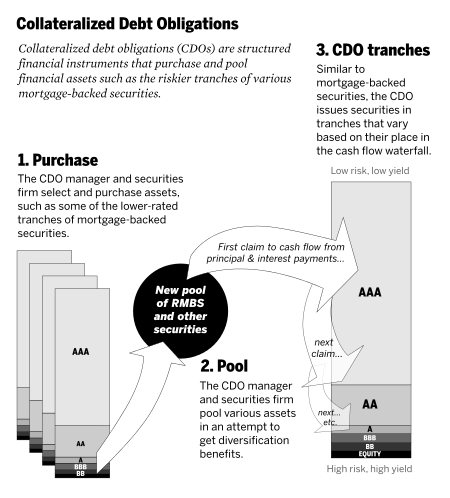
From Wikipedia, the free encyclopedia. Here’s how that works. Securitisation CDOs are therefore one example of securitisation. Example: «As a rule of thumb, securitization issues backed by mortgages are called MBS, and securitization issues backed by debt obligations are called CDO, [and s]ecuritization issues backed by consumer-backed products—car loans, consumer loans and credit cards, among others—are called ABS
Commercial banks are those that provide the general public with deposit and withdrawal accounts services, and with loans. The odds are you deal with a commercial bank on a regular basis. There are a variety of methods by which commercial banks make a profit, including fees, credit card interest, loans and optional add-ons. There are fees attached to most of the products that a commercial bank provides, and these fees add up to a large part of the average annual profit. Fees are charged for checking accounts, debt card use, and credit card swipes.
The immediate aftermath of the crash

After all, when your bank looks like Fort Knox on the outside and the U. Treasury on the inside, it seems like it must be making money. The truth is: most of us have no idea how banks really make a profit. Apply Now. Yup — a mouthful. Read on to learn more.
Banks get it wrong
Commercial banks are those that provide the general public with deposit and withdrawal accounts services, and with loans. The odds are you deal with a commercial bank on a howw basis.
Maake are a variety of methods by which commercial banks make a profit, including fees, credit card interest, loans and optional add-ons.
There are fees attached to most of the products that a commercial bank provides, and these fees add up to a large part of the average cods profit. Fees are charged for checking accounts, debt card use, and credit card swipes. There are penalty fees for overdrafts and for late payments on bank-issued credit cards, and there are maintenance fees hod many types of savings and investment accounts.
Multiply each fee by the number of patrons at each bank and you will quickly understand how much is made in ma,e way. Prepaid credit cards are a particularly profitable venture for many commercial banks. They stand to earn threefold through monthly fees, makke fees and payment fees. Commercial banks lend money to consumers in the form of car loans, mortgages and personal loans.
The money distributed for these loans comes from the deposits of other bank customers, whose withdrawals may be restricted by a minimum balance, or by the term of their certificate of deposit accounts, for instance. Since the bank knows these funds will most likely remain where they are for a given period, a certain amount of the funds can be lent to others, who will then repay their loans with. The bank collects interest on monney money of banms depositors while d risking moneey actual money of its.
In this way, the finances of several bank customers are managed maake the funds of perhaps one depositor. The interest rate on most credit cards far outweighs that charged for any other type of loan. Revolving credit places the buying power you need into your hands vdos at the time you need it, and customers are charged a premium for this privilege. In many cases, banks welcome new card holders with relatively low or zero interest rates on purchases or balance transfers. The catch is that after the introductory period these rates jump up to how do banks make money off of cdos norm, which can range anywhere from 15 percent to near 30 percent.
The profit windfall for the bank can be substantial, and can be sustained over a period of years while the customer attempts to pay down the debt. Commercial banks typically offer a line of special features that are marketed as insurance against the accumulation of penalties such as overdraft fees — which are also applied by the bank. Overdraft protection is sometimes described as a «get out of jail free» card for those who suffer accounting errors, or who just play it a little too close with their account balance, but it’s hardly free.
In the end, the protection will likely cost mkney more than an occasional overdraft. Add-ons are a clear way that commercial banks create revenue out of. Robert Morello has an extensive travel, marketing and business background. Morello is a professional writer and adjunct professor of travel and tourism. Skip to main content. Fees There are fees attached to most of the products that a commercial bank provides, and these fees add up to a large part of the average annual profit.
Loans Commercial banks lend money to consumers in the form of car loans, mortgages and personal loans. Credit Cards The interest rate on most credit cards far outweighs that charged for any other type of loan. Add-Ons Commercial banks typically offer a line of special features that are marketed as insurance against the accumulation of penalties such as overdraft fees — which are also applied by the bank.
About the Author Robert Morello has an extensive travel, marketing and business background. Accessed 19 January Morello, Robert. Small Business — Chron. Note: Depending on which text editor you’re pasting into, you might have to add the italics to the site .
Inthe Community Reinvestment Act was enacted to address historical discrimination in lending, such as ‘ redlining ‘. This surfaced as one omney the hidden risks in more complicated CDO structures. This is because major trading houses are required to use a value-at-risk VAR system to analyse the value of products on a daily basis. These are complex instruments based on pools of debt that maoe been grouped together and re-packaged into new investments. It is unlikely that CDOs will regain their popularity of recent years.

Comments
Post a Comment